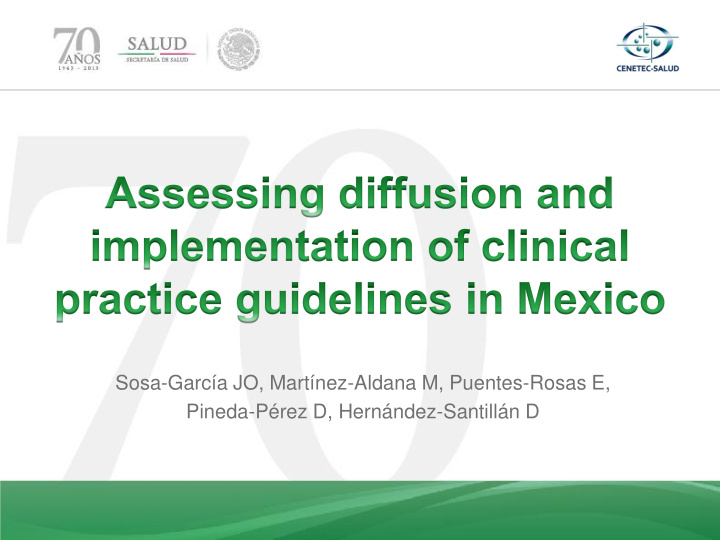



Sosa-García JO, Martínez-Aldana M, Puentes-Rosas E, Pineda-Pérez D, Hernández-Santillán D
Background • The Clinical Practice Guidelines (CPGs) developed by National Health System (NHS) in Mexico aim to improve: – The quality of health system – Reduce the heterogeneity of health care – Make more efficient use of resources. • The CPGs are related to medical practice and help to decrease its variability, standardizing the attention process and helping doctors to take the best clinical decisions. • The CPGs diffusion takes place through online Master Catalog (MC).
Aim Evaluate the success of CPGs diffusion and implementation in the medical centers of the NHS in Mexico
Methods 480 health centers were randomly sampled (IMSS, ISSSTE, SESA), 400 primary level care and 80 second level care The evaluation was conducted by an external consultant and physicians trained At each one of the centers was verified the CPGs existence: • Doctors answered a questionary to establish their knowledge, training and perception of the CPGs; • Diffusion and implementation staff also replied another questionary and clinical records were checked to confirm the CPGs use.
Results Distribution of CPGs The CPGs diffusion takes place through online MC. 80% refer to have the MC of CPGs. 1 of every 2 diffusion personnel states to have printed CPGs. The global level of training in CPGs was 56%.
Results Knowledge of CPGs INDICATOR PERCENTAGE 40% Knowledge of web site address of MC 70% Access to MC Availability of the CPGs 92% Consultation of some CPG in the last month 81% Knowledge of some other guideline 36% Knowledge of the CPGs 88%
Results Knowledge of CPGs INDICATOR PERCENTAGE 40% Knowledge of web site address of MC 70% Access to MC Availability of the CPGs 92% Consultation of some CPG in the last month 81% Knowledge of some other guideline 36% 88% Knowledge of the CPGs • The knowledge that the CPGs made by NHS are available was of 88%. • Eight of every ten interviewed doctors who know the CPGs stated having consulted them during the last month. • The 92% of the doctors who know CPGs declared that at their centers these tools are available.
INDICATOR Consider that 75% CPGs should be obligatory 78% Consider practical the format of CPGs Perception of CPGs Consider that the Results recommendations 95% PERCENTAGE should be standardized Consider that 97% CPGs improve attention quality Consider that 97% CPGs support clinical decisions Consider that should be diffused 97% since starting the professional formation
Results Diffusion and implementation
Results Diffusion and implementation BARRIERS TO DIFFUSE BARRIERS FOR IMPLEMENTATION Lack of physical equipment and material Inertia of the previous practice Lack of trained personnel to diffuse Excess of work/lack of time Excess of work/lack of time Disagreement with the concept of the CPGs Small confidence in the utility of the CPGs Lack of physical equipment and material Indisposed personnel to the use of the CPGs Indisposed personnel to the use of the CPGs Other Other
Limits Failed to get Five units the required information Lack clinical record Incomplete Understaff interview Incomplete Lack of time checklist
Bottom line The distribution of CPGs in health units is good. The knowledge and perception of CPGs by health professional are acceptable. The processes of the diffusion and implementation of the CPGs vary according to the level of care, however, further work is needed in the implementation of these tools.
THANKS cenetec@salud.gob.mx www.cenetec.salud.gob.mx Cenetec-Salud @cenetec CENETEC-SALUD
Recommend
More recommend